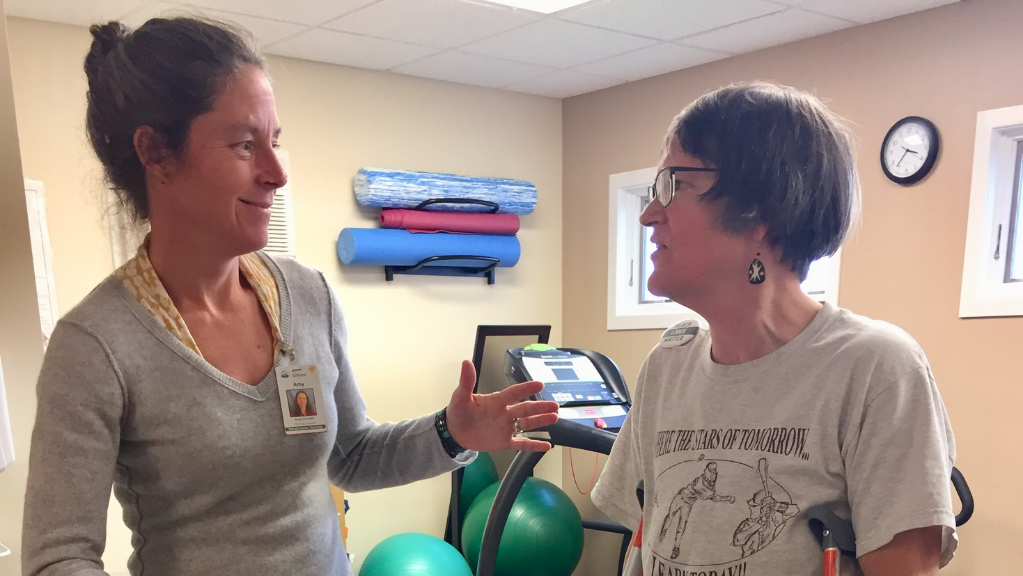
Before we know it, spring weather will be here. For some of us, that means it’s time to get back outside after essentially staying inactive over the last several months. But before you spring into action, Gifford’s Amy Chiriatti, MPT gives some advice on how to avoid getting hurt, some of the injuries she’s seen and techniques she uses to help people feel better.
Amy has been working in general outpatient orthopedics for nearly 20 years and works out of the Twin River Health Center in White River Junction with Physical Therapists Dawn Arnold and Jo Alexander, PT assistant
When it comes to getting in shape, Amy says start now.
“It’s hard on the body to just start right out of the gate straight from the couch. It’s never too early to start getting ready for whatever you want to be in shape for.”
That could mean just going out for a walk or working out with an online video that matches your level of fitness. Stretching is a big part of this process as well.
Amy says, “The body likes movement. It’s how we stay well. When people come into therapy and they’ve been sedentary, because of some pain they’ve been dealing with, we just get them to move. Getting people to get into the mindset that it’s ok to move through the discomfort is a huge part of what we do.”
High school athletes getting ready to transition to the spring sports season also need to be careful. Amy says even though you’re able to bounce back from injuries faster when you’re younger, “just remember, you’re a year older than you were when you started that sport last year.”
Amy suggests getting your body moving before you start the high physical demands of whatever your coach is asking you to do. “I think that those first couple of weeks of any sport, whether it’s the spring sport, gardening, seasonal workers or anything that’s coming out of a long, slow period of stillness is tricky. So being consistent with your activity and committed to your progress is important.”
Depending on the sport and the season, Amy and our other physical therapists are usually kept very busy.
At the Twin River Health Center, they treat student athletes in high school or nearby Dartmouth College. “When people ramp up their running, we’ll see more foot injuries. We also see foot or knee injuries in the winter along with hip injuries from hockey, skating or skiing.”
They’ve also seen shoulder issues from swimmers at the nearby Upper Valley Aquatics Center.
No matter the activity, Amy emphasizes, “giving yourself some slack. Get into it slowly, commit to something that you really want to pursue. It helps to have some goals and figure out a way to execute the goals. If you’re trying to start a new sport or meet a new goal of a running race in the fall be committed to it. I think commitment is a more valuable term than motivation when it comes to getting yourself started in a new activity.”
Amy uses several techniques in treating patients.
One of her clinical Interests is Dry Needling. She says it’s not the same as acupuncture, “There’s no hole in the needle for medicine to go through, which is the dry part. The practice and theory of Traditional Chinese Acupuncture go back centuries, and Dry Needling is much more recent. Their practice uses Meridians and works with freeing blocked energy. Much of my DN treatment involves trigger point release where I might get the needle into an active trigger point, like in the upper trapezius muscle which covers the upper back of the shoulders and neck, or in the gluteal or really any body part where there’s a spasm. Sometimes just putting a needle into an area of injury where there’s pain will help relieve it.”
According to Amy, one of the benefits of dry needling is to create microtrauma which increases blood flow for healing. “When I use a dry needle in a trigger point, sometimes I’ll manipulate the needle a little bit and I can feel the tissue change in my needle.”
Of all the manual therapies Amy uses, she says joint mobilizations are where she gets the best results, “basically, getting in there and wiggling the joints around so they move more freely in their capsule. That can relieve a lot of stress and can increase the range of motion significantly. It’s pretty powerful to see a patient walk in with a limp and then leave without a limp because you moved a particular joint or bone back into place.”
Cupping is a technique that’s been used in traditional Chinese medicine for centuries that Amy has started to try. You may have noticed pro athletes with small circles on their bodies. That’s the result of cupping, “where it just kind of sucks the skin up and stays in place. That can help decompress the tissue as opposed to compression of the tissue where you’re massaging it.
Amy’s also midway through a new course in visceral manipulation. “It’s a technique that helps to mobilize and give more mobility to the organs in the abdominal area and can help relieve different pains and issues.”
Whether it’s pain management, therapy or just getting ready to be active again, Amy says be nice to yourself.
“Pay attention to what your body is telling you in terms of aches and pains and don’t wait too long with those aches and pains before you go to a provider and get them sorted out.”
You can find out all about the advanced physical therapy provided at the Twin River Health Center, Sharon Health Center, Berlin Specialty Care Clinic and our Kingwood Health Center in Randolph. In addition to traditional orthopedic physical therapy, Gifford also offers specialized programs for bowel and bladder incontinence, lymphedema and balance disorders such as vertigo, vestibular imbalances, and general balance deficits.

